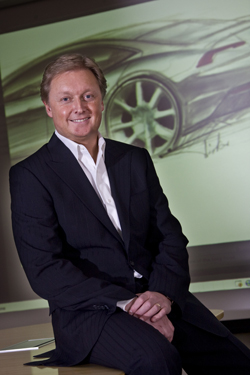
Fisker Automotive Inc.’s receptiveness to the United Auto Workers union bodes well for the electric-vehicle maker’s standing in Washington, where green companies are golden, a noted labor expert says.
“A unionized Fisker will have significantly more clout in Washington than a Fisker that’s battling a union-organizing attempt,” says Harley Shaiken, a professor at the University of California, Berkeley.
Fisker CEO Henrik Fisker repeatedly has said he would welcome a UAW-represented workforce at the auto maker’s plant in Wilmington, DE.
“My ears perked up when I heard that,” Shaiken tells Ward’s. “It’s a small footnote, but it has large implications.”
Until July 2009, the Delaware site was part of the former General Motors Corp.’s assembly network. In October, Fisker Automotive closed an $18 million deal with the bankrupt auto maker’s asset manager to acquire the plant and committed another $175 million for retooling.
These investments were made possible through a $529 million low-interest loan from a $25 billion U.S. Department of Energy program to fund development of green vehicles.
Fisker Automotive is slated to open its Delaware plant in 2012 with production of a sub-$40,000 plug-in hybrid sedan. It could be joined, as early as 2016, by a second generation of the Fisker Karma sports sedan set to launch this year from a Valmet Automotive plant in Finland.
Meanwhile, the hiring process is taking shape at Wilmington, where more than half the production will be designated for export, Fisker Automotive says.

Buzz about union organizing would alarm other auto makers. A Toyota Motor North America Inc. document that surfaced in connection with the House Oversight Committee’s current probe of sudden acceleration by Toyota vehicles, describes as a “win for Toyota” the delay of federal legislation that would streamline union organizing.
Henrik Fisker confirms he would welcome a partnership with the UAW and former GM workers. “At Delaware, we know we’ll get a highly skilled workforce with the UAW,” Fisker tells Ward’s, adding a greenfield site might attract prospective employees “who worked at McDonald’s (and) never built a car.
“We would be at a disadvantage,” he says. “Because as a startup company, one of the most important things is to have a high-quality-built car.”
Fisker is unfazed by the UAW’s sometimes volatile relationship with Detroit-based auto makers. While the union has “a certain history with certain companies,” Fisker Automotive is a new company and any contract it negotiates with the UAW will “start with a clean sheet of paper.”
He does not divulge his vision of Fisker Automotive’s compensation package, but it is clear he expects wages and benefits will not be so great as to put the startup company at risk.
“Everybody wants a job,” Fisker says. “You can only have a job if that job creates something you can sell. If nobody wants it because it’s too expensive, then you don’t have a job. It’s that simple.
“Everybody realizes that we have to produce something that is at least competitive,” he says, acknowledging Fisker Automotive has had conversations with UAW officials, including the union’s president, Ron Gettelfinger. “So far we’ve only had good talks with the UAW,” Fisker says.
Gettelfinger, in a recent interview with Ward’s, notes the UAW will only seek to represent Fisker Automotive employees if the union is approached by those employees. But he was impressed with the auto maker’s executives after spending nearly an entire day with them when the Delaware investment was announced.
“They are a very swift group,” Gettelfinger says. “They make decisions and move forward. They’ve got a lot of expertise behind them.”
Fisker’s background includes stints at BMW AG, where he designed the Z8 roadster, and Ford Motor Co. There he penned the Aston Martin DB9 and V8 Vantage, while also serving on the ultra-luxury brand’s board of directors.
Fisker Automotive’s investors include Silicon Valley-based private-equity giant Kleiner Perkins Caufield & Byers.
At this week’s Geneva auto show, Fisker Automotive reveals details of the Karma’s space frame. Featuring a multi-cell tempered aluminum construction and dual-phase steel-reinforced door components and B-pillars, it not only insulates occupants from high-energy impacts, it protects the car’s lithium-ion battery.
The Karma’s battery will be supplied by Massachusetts-based A123 Systems after the auto maker abandoned talks with EnerDel Inc., an Indiana-based unit of Ener1 Inc.
The Geneva preview comes on the heels of a move to consolidate Fisker Automotive’s design, engineering, sales, marketing and administrative operations at its corporate headquarters in Irvine, CA.
The move is intended to advance the progress of Project NINA, codename for the car destined for production at Wilmington.
The codename NINA is inspired by one of the ships Christopher Columbus sailed on his epic 1492 journey to North America.
Among Fisker’s top priorities as his company prepares to launch the Karma is fuel-economy ratings. Because the Karma is a plug-in hybrid, test cycles for vehicles currently on the market don’t apply, he says.
Fisker believes the Karma, “for most consumers,” will achieve performance in the range of 100 mpg (2.4 L/100 km).
“You wouldn’t rate a gasoline engine saying, ‘What if I leave it in second gear?’” he says. “Which means (the Karma) shouldn’t be rated (as) pure electric or pure gasoline. It should be a combined average.”
The Environmental Protection Agency acknowledged in September a unique rule likely is required for rating plug-in hybrid fuel economy. “Nothing has been proposed yet,” an EPA insider tells Ward’s.


